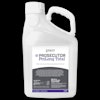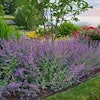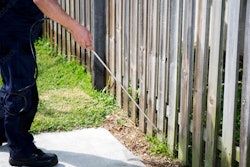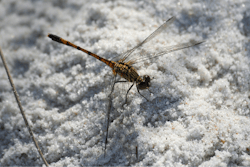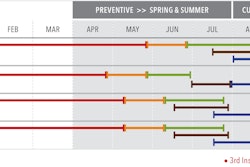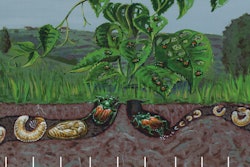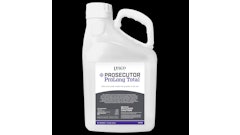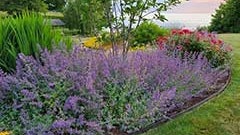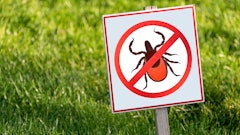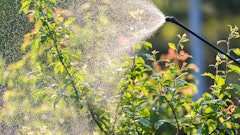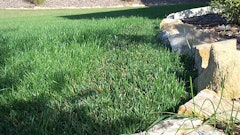
Top lawn care specialists from Syngenta, Nufarm, FMC Corp., SiteOne Landscape Supply and Corteva describe which early-summer insects lawn care professionals should know about and discuss how to control them.
 Dark in color with shiny, light-colored wings, chinch bugs can range in size from 0.1 to 0.5 inch long.Steve McDonald, Turfgrass Disease Solutions
Dark in color with shiny, light-colored wings, chinch bugs can range in size from 0.1 to 0.5 inch long.Steve McDonald, Turfgrass Disease Solutions
1. Chinch bugs
 Grubs spend their live in the soil and may be difficult to reach with control products.Matt Giese, Syngenta
Grubs spend their live in the soil and may be difficult to reach with control products.Matt Giese, Syngenta
2. Grubs
Identification: Varying in size from 1/4 inch to 11/2 inches, white grubs have a creamy white, C-shaped body, six legs and a brownish head. The tail end of a grub is called the raster.
Damage: Grub damage looks like brown, thin or dead patches of grass that may be random, irregular or isolated. The grass may be loose and roll up easily. The turf can also feel spongy.
Location: Grubs can be found throughout most of the continental U.S.
Control: Target the adult beetle. In the Southern U.S., treat chemically for adult grubs during June through mid-July to prevent adults from laying eggs into the soil. Using a contact product, eradicate what is in the soil at that time. Earlier-season preventive applications with a residual systemic insecticide can provide seasonlong control. Use a neonicotinoid insecticide or a diamide like chlorantraniliprole in the late spring to middle of summer when the larvae hatch. Diamides can be used in places where neonicotinoids are not allowed. Curative products like carbaryl or trichlorfon can be applied in the soil to control larval stages. For biological control, milky spore bacterium can be used.
Additional info: Adults emerge in midsummer to mate and lay eggs, which hatch in about two weeks. Once the eggs hatch, those grubs feed on the grass roots from late summer into the fall. If it’s known that a specific property is infested, be proactive and make sure that lawn has adequate fertility and moisture.
 Billbug larvae are creamy white with a brownish head and are legless. However, adults are 0.25 to 0.5 inch long with an elongated snout.David Shetlar
Billbug larvae are creamy white with a brownish head and are legless. However, adults are 0.25 to 0.5 inch long with an elongated snout.David Shetlar
3. Billbugs
Identification: Billbug larvae are creamy white with a brownish head and are legless. When fully developed, they are 1/4 to 1/2 inch long with an elongated snout.
Damage: Adults will chew a hole in the grass blade and lay an egg. When the larvae emerge, they’ll feed from the inside out of that leaf blade. Early signs of damage are small irregular areas of brown, dying turf that spread. In damaged areas, pull back the grass, and it will break off at the soil. A powdery frass or excrement from the insect will be visible on the soil line.
Location: Billbugs can be found throughout the continental U.S.
Control: Billbug populations can be managed with resistant turf varieties, adequate irrigation and proper fertilization, as well as by raising the mowing height slightly. Pyrethroid insecticides can be used to reduce adult populations, and neonicotinoid and diamide insecticides can be used to target early-stage larvae. Apply insecticides in the spring to treat both larvae and adults. Imidacloprid and thiamethoxam insecticides can help get rid of insects before they move into the crown of the plant.
Additional info: The two common billbugs are the bluegrass billbug and the hunting billbug. Each can be found in warm- and cool-season turfgrass. If a property has a history of billbugs, more treatments may be required. Billbugs don’t fly or walk well.
 The mature larvae of fall armyworm can be identified by the inverted "Y" pattern on its face.Jim Castner, UF/IFAS
The mature larvae of fall armyworm can be identified by the inverted "Y" pattern on its face.Jim Castner, UF/IFAS
4. Fall armyworms
Identification: Fall armyworms can be identified by an inverted white “Y” pattern along their face.
Damage: Armyworms cross the turf surface as a group and create a noticeable line between damaged and undamaged turfgrass. Damaged areas will often originate around a site where egg masses can be easily laid, such as sign posts and buildings and expand outward. Newly installed sod is more susceptible to damage.
Location: Found throughout the U.S., fall armyworms are more notorious in the Southeast for the extent of the damage they can cause but are an occasional pest in the Southwest from northern Texas across to California.
Control: Fall armyworms can have multiple hatches that last longer than some product residuals. Insecticides with active ingredients such as chlorantraniliprole and tetraniliprole can be effective for long-term control. Bifenthrin can be a highly effective when used curatively as a rescue treatment.
Additional info: Large armyworm populations can feel like they emerged overnight and do not stop eating from the moment they emerge from an egg until they pupate.
 Caterpillars that curl into a “C” shape when picked up, the black cutworm is a common species and can be identified by its overall “greasy” appearance and a typically brownish head.John Capinera, University of Florida, bugwood.org
Caterpillars that curl into a “C” shape when picked up, the black cutworm is a common species and can be identified by its overall “greasy” appearance and a typically brownish head.John Capinera, University of Florida, bugwood.org
5. Cutworms
Identification: Cutworms are caterpillars that curl into a “C” shape when picked up. The black cutworm is a common species and can be identified by its overall “greasy” appearance, uniform body color and a typically brownish head. Some older larvae have a netting pattern over their eyes.
Damage: Cutworm damage looks like small pock marks. Closer examination reveals a small burrow and several grass plants around the perimeter of the burrow that have been sheared off near ground level. Often, these burrows are lined with green, pellet-like matter. This is caterpillar frass, or excrement.
Location: Cutworms can be found across the entire continental U.S, but this species does not tolerate colder temperatures.
Control: The first and second instars of the larval stages of cutworms and armyworms are small and easily missed. The “dish soap” method can be used to monitor for cutworms present in the thatch and soil surface. In healthy turfgrass, pour a mixture of 1 to 2 tablespoons of dish soap with 1 to 2 gallons of water over 1 square yard area and wait five to 10 minutes and see if any insects emerge.
Additional info: Cutworms get their name because they “cut” through plant stems at the soil surface when they are feeding, usually targeting young plants or seedlings.
6. Fire ants
Identification: Fire ants are dark-reddish brown ants with shiny dark abdomens. They are about 1/16 inch to 1/4 inch long and are distinguished by two nodes on the petiole between the thorax and abdomen.
Damage: Fire ants nest in the ground and become more apparent when there is heavy rain because they’ll start building their nests above the ground. These mounds can become an issue when mowing and will likely kill any grass underneath them.
Location: Fire ants are typically most prevalent in southern parts of the U.S.
Control: Mound treatments using spinosad and acephate perform well but may require multiple treatments over the season. Another treatment option would be broadcast applications that are applied to the whole lawn. An insecticide with an AI such as phenylpyrazole is a popular option, as are pyrethroids like bifenthrin. Depending on the treatment method, broadcast applications may also require multiple applications per year. There are also bait products like hydramethylnon. Baits should be applied when the ground is dry, and rain isn’t expected for 24 hours. Another option would be to combine treatments, such as a mound treatment and a broadcast application. When lawn care operators treat a mound, the ants will move just a few feet over, so by combining treatments, they can treat the whole yard and prevent them from moving to another area of the yard. Late spring and early fall are good times to treat fire ants. Treatments should be applied when ants are actively foraging, so a late afternoon or early evening application is best.
Additional info: The most notable identifier for these pests is their painful bite to humans and animals. In the spring, you’ll see these ant mounds near sidewalks and driveways where they’re attracted to the warmth of a hard surface that heats up.
7. Sod webworms
Identification: Sod webworm moths can be white, gray or tan and dingy in appearance with snoutlike projections. Sod webworm larvae grow to 3/4 to 1 inch long and vary in color by species. Adults have wing spans up to 1 inch and typically fly in short, zig-zagging spurts.
Damage: Sod webworm larval damage often is observed as brown patches up to the size of a baseball in the lawn. In some instances, the brown patches are punctured with pencil-sized holes a result of birds searching for the webworm burrows.
Location: Sod webworms are more common in the southern U.S.
Control: A granular insecticide containing the active ingredients such as bifenthrin will eradicate emerging caterpillars. Pesticide containing Bacillus thuringiensis can also combat the larvae without harming other beneficial insects. Treat for sod webworms when they are very young, before severe damage occurs. By early fall, they will begin to transform into adults and will be much more difficult to control.
Additional info: Sod webworms live in the thatch, just above the soil, where they spin a light webbing and feed on the undersides of leaves.
For information on the top ornamental pests, follow this link.
For more tips on controlling turfgrass pests, follow this link.
Sources: Ben Hamza, Ph.D., product development director, FMC Corp.; Edwin Afful, Ph.D., insecticides product development manager, FMC Corp.; Julia Willingham, SiteOne business development manager, pest management; Amy Agi, Ph.D., field scientist for Corteva U.S. Turf & Ornamental; Matt Giese, technical services representative for the Midwest for Syngenta; and Richard Fletcher, technical services manager for turf & ornamental at Nufarm.

